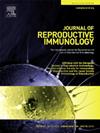Placental volume as a potential early marker for metabolic pertubations during pregnancy
IF 2.9
3区 医学
Q3 IMMUNOLOGY
引用次数: 0
Abstract
The placenta has a central function in fetal glucose supply and placental volume has received rising awareness as a potential predicting factor for adverse pregnancy outcomes. We aimed to examine whether placental volume is a prognostic marker for metabolic perturbations affecting both mother and child. Data from 100 women participating in a longitudinal cohort study of healthy pregnant women were obtained. Placental volume was assessed via transabdominal ultrasound at gestational weeks 12–14. Additional ultrasound measurements were conducted at gestational weeks 23–25, 28–30, and 34–36 to assess fetal anthropometry. HbA1c was measured in first trimester blood samples. Both cross-sectional and prospective associations between first trimester placental volume and selected fetal and maternal parameters were examined using multivariable linear regression models. Interactions by gender were observed for associations with HbA1c, anterior abdominal wall thickness (AAWT), gestational weight gain and estimated fetal weight. A higher first trimester placental volume was related to higher HbA1c levels in the first trimester, higher AAWT measures in the third trimester, and greater gestational weight gain in women carrying a male fetus only (all p = 0.02). In women carrying a female fetus, a positive association was observed between placental volume and estimated fetal weight at gestational week 34–36 (p = 0.045). None of the other maternal or fetal parameters were related to placental volume (p ≥ 0.1). Our results indicate first trimester placental volume to be a potential prognostic factor for maternal glucose metabolism and both fetal and maternal anthropometric perturbations particularly for those mothers carrying a male fetus.
胎盘体积作为妊娠期代谢紊乱的潜在早期标志物
胎盘在胎儿葡萄糖供应中起着核心作用,胎盘体积作为不良妊娠结局的潜在预测因素已受到越来越多的关注。我们的目的是研究胎盘体积是否是影响母亲和孩子的代谢紊乱的预后标志。从参与健康孕妇纵向队列研究的100名妇女中获得数据。在妊娠12-14周通过经腹超声评估胎盘体积。在妊娠23-25周、28-30周和34-36周进行额外的超声测量以评估胎儿的人体测量。在妊娠早期血液样本中测量HbA1c。使用多变量线性回归模型检验了妊娠早期胎盘体积与胎儿和母体选定参数之间的横断面和前瞻性关联。性别之间的相互作用与HbA1c、前腹壁厚度(AAWT)、妊娠体重增加和估计胎儿体重有关。妊娠早期较高的胎盘体积与妊娠早期较高的HbA1c水平、妊娠晚期较高的AAWT水平以及仅怀男性胎儿的女性妊娠体重增加有关(p均 = 0.02)。在携带女性胎儿的妇女中,胎盘体积与妊娠34-36周胎儿体重呈正相关(p = 0.045)。其他母胎参数均与胎盘体积无关(p ≥ 0.1)。我们的研究结果表明,妊娠早期胎盘体积是母体葡萄糖代谢和胎儿及母体人体测量扰动的潜在预后因素,特别是对于那些携带男性胎儿的母亲。
本文章由计算机程序翻译,如有差异,请以英文原文为准。
求助全文
约1分钟内获得全文
求助全文
来源期刊
CiteScore
6.30
自引率
5.90%
发文量
162
审稿时长
10.6 weeks
期刊介绍:
Affiliated with the European Society of Reproductive Immunology and with the International Society for Immunology of Reproduction
The aim of the Journal of Reproductive Immunology is to provide the critical forum for the dissemination of results from high quality research in all aspects of experimental, animal and clinical reproductive immunobiology.
This encompasses normal and pathological processes of:
* Male and Female Reproductive Tracts
* Gametogenesis and Embryogenesis
* Implantation and Placental Development
* Gestation and Parturition
* Mammary Gland and Lactation.

 求助内容:
求助内容: 应助结果提醒方式:
应助结果提醒方式:


